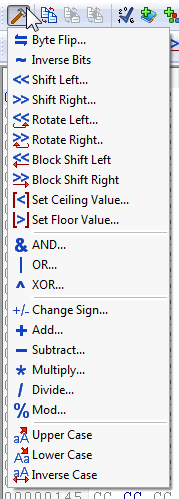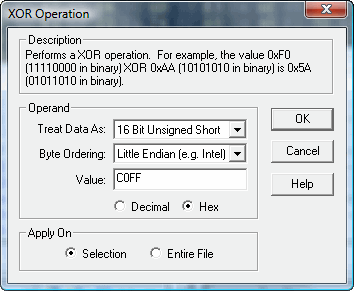Hex Workshop supports integrated data operations within the hex editor.
This allow users to perform arithmetic and logical operations on their
data while interpreting their data as decimal or other values.
|
Byte Flip |
Flip the order of bytes. For example, 0xABCD
would become 0xCDAB.
This operation can be performed on 16, 32, and 64 bit data blocks. |
|
Inverse Bits |
Inverse the bits. For example 0xA0 (10100000)
would become 0x5F (01011111).
This operation can be performed on data blocks of any size. |
|
Shift Left |
Shift bits to the left by 1 bit.
This operation can be performed on 8 bit, 16 bit, 32 bit, or 32 bit
data blocks in either Big Endian or Little Endian Byte order. |
|
Shift Right |
Shift bits to the right by 1 bit.
This operation can be performed on 8 bit, 16 bit, 32 bit, or 32 bit
data blocks in either Big Endian or Little Endian Byte order. |
|
Rotate Left |
Rotate bits to the left by 1 bit.
This operation can be performed on 8 bit, 16 bit, 32 bit, or 32 bit
data blocks in either Big Endian or Little Endian Byte order. |
|
Rotate Right |
Rotate bits to the right by 1 bit.
This operation can be performed on 8 bit, 16 bit, 32 bit, or 32 bit
data blocks in either Big Endian or Little Endian byte order. |
|
Block Shift Left |
Block shift bits to the left by 1 bit (bits are carried across byte
boundaries).
This operates at a byte level and can be performed on data blocks of
any size. |
|
Block Shift Right |
Block shift bits to the right by 1 bit (bits are carried for across
byte boundaries).
This operates at a byte level and can be performed on data blocks of
any size. |
|
XOR |
Perform XOR (Exclusive OR) on data.
This operation can be performed on 8 bit, 16 bit, 32 bit, or 32 bit
data blocks in either Big Endian or Little Endian byte order. |
|
OR |
Perform bitwise OR on data. Requires additional parameter.
This operation can be performed on 8 bit, 16
bit, 32 bit, or 32 bit data blocks in either Big Endian or Little Endian
byte order. |
|
AND |
Perform bitwise AND on data. Requires additional parameter.
This operation can be performed on 8 bit, 16 bit, 32 bit, or 32 bit
data blocks in either Big Endian or Little Endian byte order. |
|
Change Sign |
Change sign from negative to positive or from positive to negative.
This operation can be performed on 8 bit, 16
bit, 32 bit, and 64 bit integers and float or doubles under Big Endian
or Little Endian byte order. |
|
Add |
Add value to data.
This operation can be performed on 8 bit, 16
bit, 32 bit, and 64 bit integers (signed or unsigned) and float or doubles
under Big Endian or Little Endian byte order. |
|
Subtract |
Subtract value from data.
This operation can be performed on 8 bit, 16
bit, 32 bit, and 64 bit integers (signed or unsigned) and float or doubles
under Big Endian or Little Endian byte order. |
|
Multiply |
Multiply data by a value.
This operation can be performed on 8 bit, 16
bit, 32 bit, and 64 bit integers (signed or unsigned) and float or doubles
under Big Endian or Little Endian byte order. |
|
Divide |
Divide data by a value.
This operation can be performed on 8 bit, 16
bit, 32 bit, and 64 bit integers (signed or unsigned) and float or doubles
under Big Endian or Little Endian byte order. |
|
Modulo Division |
Perform modulo division on data.
This operation can be performed on 8 bit, 16
bit, 32 bit, and 64 bit integers (signed or unsigned) and float or doubles
under Big Endian or Little Endian byte order. |
|
Set Floor Value |
Sets the minimum/floor value. If any values are lower than the specified
value, then the value is replaced with another value.
This operation can be performed on 8 bit, 16
bit, 32 bit, and 64 bit integers (signed or unsigned) and float or doubles
under Big Endian or Little Endian byte order. |
|
Set Ceiling Value |
Sets the maximum/ceiling value. If any values are greater than the specified
value, then the value is replaced with another value.
This operation can be performed on 8 bit, 16
bit, 32 bit, and 64 bit integers (signed or unsigned) and float or doubles
under Big Endian or Little Endian byte order. |
|
Upper Case |
Convert ASCII characters to upper case. Non-alphabetic characters are
not changed. |
|
Lower Case |
Convert ASCII characters to lower case. Non-alphabetic characters are
not changed. |
|
Swap Case |
Swaps the case of ASCII characters: lower case becomes upper case, uppercase
becomes lower case, non-alphabetic does not change. |
Hex Workshop will prompt you when additional parameters are required.
A sample dialog is shown below:
Hex Workshop needs to interpret the data as a decimal value for most
data operations. For example, rotating 4 individual bytes will yield different
results than rotating a single long which is 4 bytes in length. Signed
vs Unsigned status is only used for arithmetic operations.
Hex Workshop allows you to interpret data in either Little Endian (e.g.
Intel) or Big Endian (e.g. Motorola) byte ordering. Please see Understanding Byte Ordering
for more information on byte ordering in general.
Users can enter a decimal or hexadecimal operand for operations. You
can toggle between hexadecimal and decimal by selecting the appropriate
"Decimal" or "Hex" radio button.
Hex Workshop can apply the operation on either a selection or your entire
document. The "Selection" radio button will be disabled if the
dialog is invoked without a selection.


